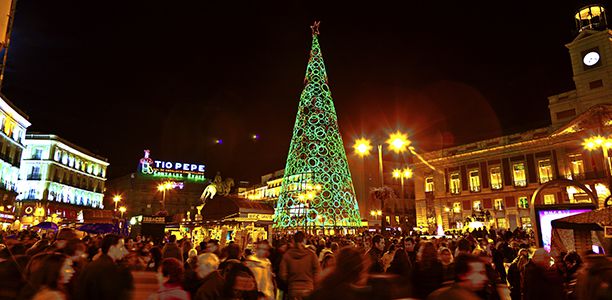Traditional Christmas celebrations in Spain vary greatly in different regions of the country. This is due to the fact that Spain incorporates people from different cultures with their own customs, cuisine and languages which are influenced by different histories and geographies. However the majority of Spanish people are Catholic, so for most Spanish families Christmas is a religious celebration of the birth of Jesus.
Christmas word Spanish translation
Christmas: Navidades (Christmas season) or Navidad (Christmas day)
Date: 25th December but the main day for exchanging gifts is January 6.
Santa Claus: Papá Noel is more of a recent figure adopted from the Americas. Traditionally in Spain it is not Santa Claus but the Three Kings (Los Reyes) who deliver presents to the entire family.
Christmas Eve: Nochebuena
Christmas tree: Another recent American import, the Christmas tree has been included in the Christmas décor only in the last 10 years or so.
Merry Christmas: Feliz Navidad.
Nativity: El Belén
Christmas preparations
Christmas festivities in Spain officially start early in December. Shops and city streets are lit up with elaborate Christmas trees and fairy lights of various colours. The hustle and bustle of the cities becomes more intense as people come out to join in the festivities.
December long weekend and Feast of the Immaculate Conception
The long weekend in early December, held to celebrate Spanish Constitution Day, also marks the start of the Christmas celebrations. It also encompasses celebrations of the Immaculate Conception of the Virgin Mary; Catholics and many other Christians believe that Mary, the mother of baby Jesus was conceived by her parents in the absence of original sin (sex). December 8 marks the date on which Mary was conceived.
Christmas markets
 Christmas markets are held in plazas in many Spanish towns and cities in the lead up to Christmas. They usually open on the long weekend of the Immaculate Conception and continue up to Christmas day. Some even continue operating until the festive season officially ends on January 6. You can find everything from trinkets, Christmas decorations, presents and even food products, such as cheese or cider, and the traditional Spanish sweets, such as turrón, polvorones, mantecados, among others.
Christmas markets are held in plazas in many Spanish towns and cities in the lead up to Christmas. They usually open on the long weekend of the Immaculate Conception and continue up to Christmas day. Some even continue operating until the festive season officially ends on January 6. You can find everything from trinkets, Christmas decorations, presents and even food products, such as cheese or cider, and the traditional Spanish sweets, such as turrón, polvorones, mantecados, among others.
Christmas trees and lights
Many families also begin their Christmas decorating on the December long weekend. Christmas trees are starting to become popular, since Spain has long been a very traditionally Catholic country the most important of these decorations was often the Nativity.
Nativity scenes
The Christmas tree is a recent import on the Spanish Christmas decorating landscape. The main star of the festive season has traditionally been, and still is, the Nativity scene. In Spain it is popularly referred to as el Belén and governments and families around the country pay considerable attention to designing intricate nativity scenes. In many areas, city halls or other institutions create el Belén large enough for people to walk through. Some even include running water in the rivers!
Inside people’s houses nativity scenes are generally not as large but they are still very intricate set-ups depicting much more than the usual holy family. Scenes around the manger show many additional characters including visitors on their way to see the newborn King, baby Jesus and workers doing chores. The most peculiar of these characters is undoubtedly one from a region of Spain called Catalonia. Named Caganer, this character is a man caught going to the bathroom, typically placed in an inconspicuous area, usually behind a bush of some sort.
Letters to Santa Claus
The lead up to Christmas is also a time when children are writing letters to the Spanish equivalent of Santa Claus which is the Three Wise Men of Orient or Three Kings. Unlike in many countries of the world where Santa Claus delivers children presents on Christmas Eve, in Spain children have their presents delivered by the Three Wise Men and they have to wait until after the New Year to receive them!
National Christmas Lottery
The Spanish National Christmas Lottery (Lotería de Navidad) is not just any lottery. It has been held since 1812 and it is a major institution in Spain. Every year in the lead up to Christmas, Spaniards flock to buy a Décimo that is one tenth of a ticket in the National Lottery. El Gordo or jackpot, is only attainable with a whole ticket (10 décimos) but even a single décimo can return a prize of up to €400,000.
The lottery draw on December 22 is a highly anticipated event, broadcast in its entirety. While people are obviously interested in the results and hoping for a big win, the event is also popular because of the unique characteristics of the draw. Children who attend the San Ildefonso School (until very recently a school exclusively for orphans) chant, in a very unique way, the winning numbers which they themselves draw.
Christmas Eve
Christmas Eve is the main day for gathering with family to celebrate Christmas in Spain.
Christmas Eve dinner
Spanish families get together on Christmas Eve (Nochebuena) to have dinner. Some people, especially young people, go out after dinner and dessert. Although this is not rare and a few businesses and bars open, most people tend to spend a night like this at home with the family.

Christmas Eve dinner is perhaps the most lavish meal of the year. Families start by toasting with glasses filled with Cava, the Spanish sparkling wine and then the feast begins. Delicacies on offer at a Spanish Christmas Eve feast typically include a variety of meats including turkey or lamb and the traditional Spanish cold cuts, like the world famous Iberico ham. Many families also eat a wide variety of seafood.
It’s amazing that there’s any room left for the must-have exotic deserts. Many different kinds of traditional Spanish sweets are enjoyed in the days leading up to Christmas and especially on Christmas Eve including polvorones, mantecados, turrones and mazapanes.
Singing Christmas carols
After all the eating some families continue the long-standing tradition of singing Christmas Carols (Villancicos). These Christmas Carols are not mere translations of more internationally known carols. Some are songs that date back to medieval times. Even the name Villancicos started long before the songs were exclusively related to Christmas. Now there are more and more carols composed in the other languages of Spain (Catalan, Galician, Basque, and Asturian), and in the south there’s compositions with a flamenco influence.
Religious activities
The most religious families may attend Misa del Gallo, a midnight mass service commemorating the birth of Jesus Christ. The event has started to be televised in recent years, so families who can’t move after all the eating can still follow the service from the comfort of their homes.
Christmas day
Christmas Day in Spain has traditionally been a day to spend quietly with family.
Christmas lunch
The main Christmas day event is a big lunch. Food includes everything from leftovers to more freshly cooked dishes.
Sobremesa (after-meal talk)
Christmas lunch in Spain is traditionally followed by a long Sobremesa, that is, lots of chatting after the meal. Some liquors may be served to aid in digestion, the most famous being Patxaran, from Basque origin, and Anis, another Spanish staple.
Modern traditions
In the last decade American Christmas traditions such as the Christmas tree and Santa Claus have become increasingly popular in Spain. Alongside these changes new Christmas day traditions, especially the tradition of exchanging gifts has become more common.
Post-Christmas
In Spain the post-Christmas period is also a time of great festivity and the time when Spanish families receive gifts from the Three Kings.
Santos Innocentes (April Fool’s Day)
Santos Innocentes is the Spanish equivalent of April Fool’s Day in December. It commemorates the biblical episode of the Massacre of the Innocents, where according to the Gospel of Mathew, Herod sent orders to kill all children in Judea under the age of 2.
People play pranks on each other, or inocentadas. Each city celebrates this day in different ways, for example, one of the most elaborate celebrations is called “Els Enfarinats”, a festivity in Alacant where people dress in military outfits and throw a mock coup d’etat, followed by a fight with flour and eggs.
Three Kings Parade (Cabalgata de Reyes)
 The Cabalgata de Reyes is a big parade held in every major city on January 5, in preparation for the Three Kings’ Day on January 6th. The parade marks the arrival of the Three Kings who will deliver gifts to every house the following day. Every King is displayed on a separate float and throws candy to the children on the sides of the road. Each float is preceded by many characters, traditionally religious figures. Nowadays it is not uncommon to find a host of non-religious characters including cartoon figures walking before the floats. The biggest of these parades is held in the capital Madrid, and is televised nationally.
The Cabalgata de Reyes is a big parade held in every major city on January 5, in preparation for the Three Kings’ Day on January 6th. The parade marks the arrival of the Three Kings who will deliver gifts to every house the following day. Every King is displayed on a separate float and throws candy to the children on the sides of the road. Each float is preceded by many characters, traditionally religious figures. Nowadays it is not uncommon to find a host of non-religious characters including cartoon figures walking before the floats. The biggest of these parades is held in the capital Madrid, and is televised nationally.
Day of the Kings (Día de Reyes)
Día de Reyes occurs on January 6 and commemorates the coming of the Three Kings (Los Reyes) bearing gifts to baby Jesus. And unlike Santa who only gives to children, Los Reyes bring gifts for the whole family. The only ones who miss out are those who’ve been bad. They get the dreaded coal.
 Día de Reyes is a day to spend with the family and eat…especially the Three Kings Cake (Roscón de Reyes). As with other traditions during Christmas, the recipe for this popular Spanish pastry varies depending on the region. It’s called a cake but it really looks more like a giant donut with candied fruits on top. It may come filled with cream, whipped cream or not filled at all, but the one thing they all have in common is that a little “surprise” is baked inside, usually a small plastic figure. Tradition says that whoever gets the surprise in their portion of Roscón has to pay for it.
Día de Reyes is a day to spend with the family and eat…especially the Three Kings Cake (Roscón de Reyes). As with other traditions during Christmas, the recipe for this popular Spanish pastry varies depending on the region. It’s called a cake but it really looks more like a giant donut with candied fruits on top. It may come filled with cream, whipped cream or not filled at all, but the one thing they all have in common is that a little “surprise” is baked inside, usually a small plastic figure. Tradition says that whoever gets the surprise in their portion of Roscón has to pay for it.
References
- Institute of Tourism of Spain. Languages and Religion. 2014. (cited 15 December 2014). Available from: [URL Link]
Read More
 |
Find out about Christmas celebrations in other parts of the world. |




 (4 votes, average: 3.75 out of 5)
(4 votes, average: 3.75 out of 5) 






